On Kefalonia, Winemakers Adapt to Rising Temperatures
Climate change brings water scarcity and...
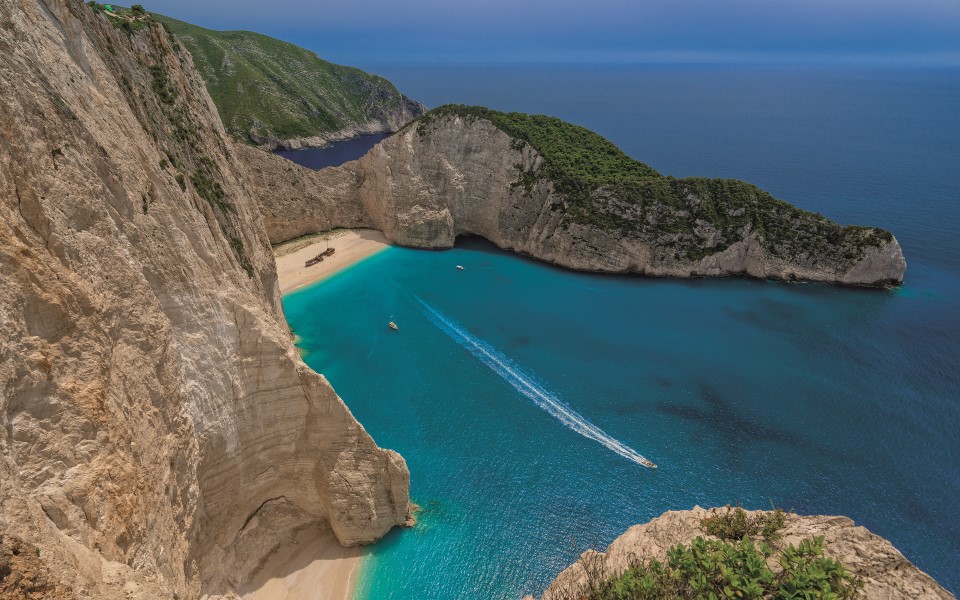
The world-famous Navagio (Shipwreck) Beach.
© Perikles Merakos
The ferry from Kyllini approaches the port of Zakynthos Town in the afternoon, and I lay eyes on the twin hills of Bohali and Xintavelonis, with a gorge between them like someone’s taken a bite out of the land.
I read somewhere that these two hills were separated by a strong earthquake just a few centuries ago. The more recent earthquake of 1953 altered the look of the town completely, destroying its most beautiful mansions and townhouses.
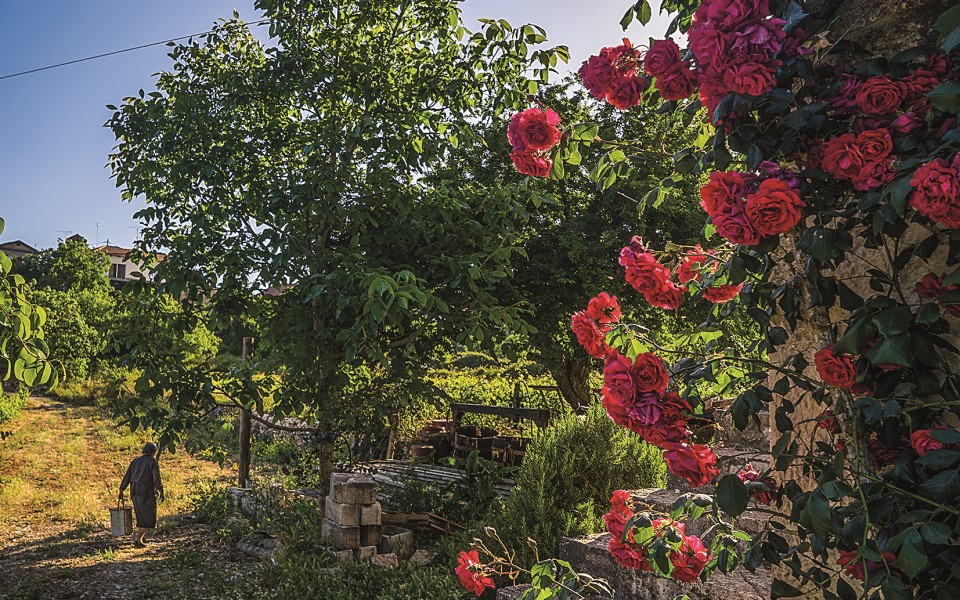
Zakynthos’ verdant interior, full of vineyards and olive groves, is just as beautiful as its famous beaches.
© Perikles Merakos
Disembarking, I walk upwards through the Psiloma area to Bohali and the Venetian fortress there, now ruins in the dense pine forest. If I’m fortunate, I’ll get to enjoy a classical or jazz concert here one night, seated among the great stone remains.
After the fortress, I walk down to one of the patisseries in Bohali to enjoy a Zakynthian “frygania”, the island’s most famous sweet, with a syrup-drenched rusk, custard, whipped cream and glacé cherries. It’s old-fashioned, and totally delicious.
I leave the town and head to the mountain villages of Zakynthos, which almost make me forget that I’m on an island. In total silence I wander the labyrinthine cobbled streets of the villages of Loucha and Gyri in the heart of the island’s interior, then quench my thirst with an ice-cold beer from Babis’ kiosk-café on the road leading into Loucha, in the middle of the forest with a view of the lush high plateau.
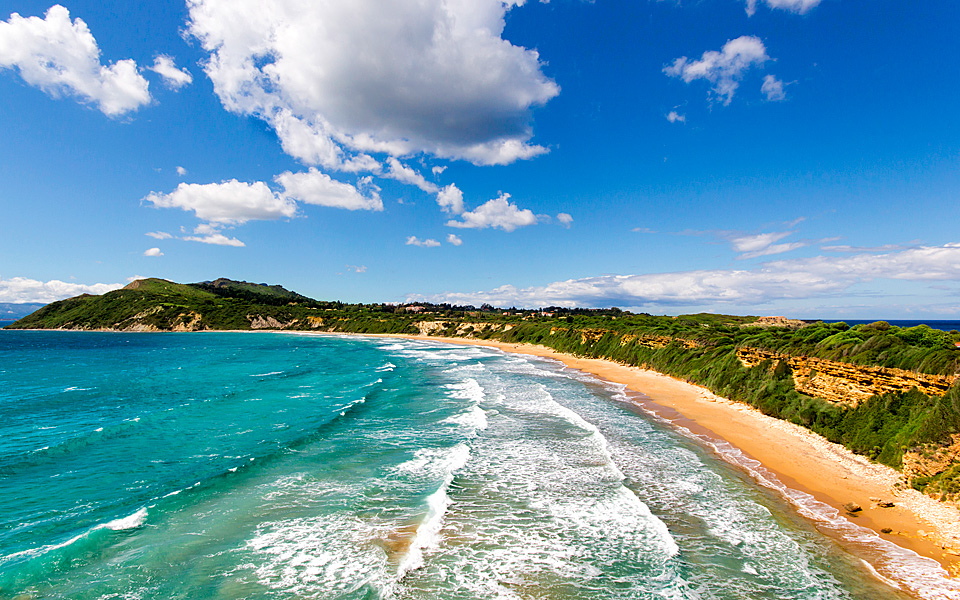
Endless sandy beaches are plentiful on the island.
© Shutterstock
I return again and again to the ruins of the abandoned villages on the Vrachionas mountain range, a rocky spine which bisects the island: old Koukesi, old Langadakia, old Katastari, ghostly remnants of the 1953 earthquake.
Narrow alleyways, walls with empty window frames that no longer divide the inside from the outside, overgrown yards, drystone walls, churches and bell towers, all half-derelict and covered in ivy. You won’t find these pictures of Zakynthos in the guidebooks, but photographers visit here all the time, each finding their own stark beauty.
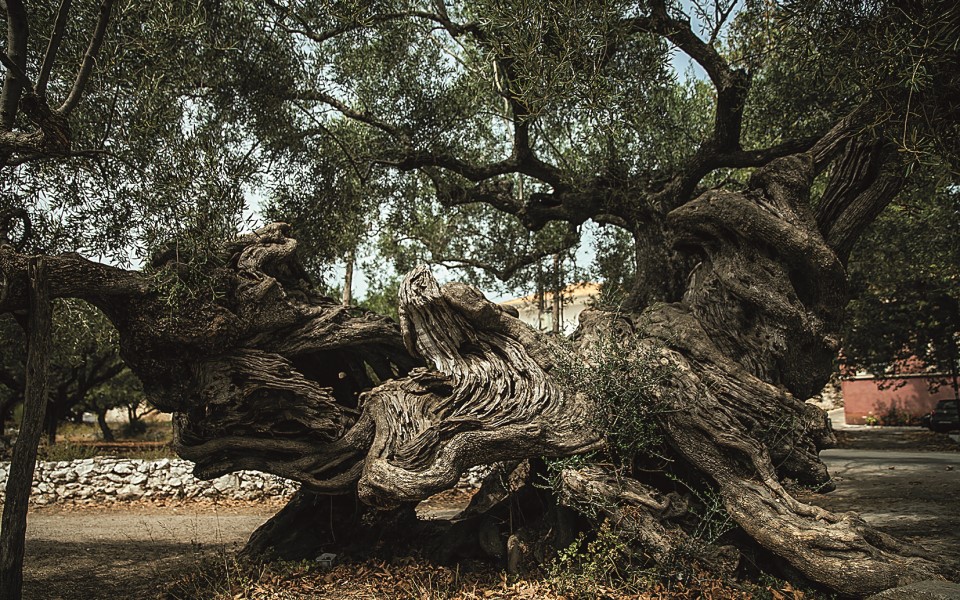
The impressive ancient olive tree in the mountain village of Exo Hora.
© Dimitris Vlaikos
Next, I head to the north of the island and to the villages on the slopes here – Maries, Anafonitria, Volima, Orthonies, Exo Hora and Kambi – where I stop at the local cafés to sample the best meze.
A favorite of mine is called dopio, or “local.” It’s a sharp, spicy Zakynthian cheese matured in olive oil for several months and often served with fried eggs, tomato, and the island’s special ham, a robust cured meat prepared according to a recipe inherited from the Venetians.
A good taverna owner or grocer will always make their own dopio and ham, and I decide to stock up on both to take back with me to Athens. “Dopies,” the feminine plural of dopio, is the name given by the Zakynthians to the ancient olive trees of the mountain groves. They have giant trunks, often so gnarled and twisted that they resemble living sculptures. On a corner of the main street in the village of Exo Hora stands perhaps the most impressive of these, in front of the village square, but hundreds more of these “dopies” can be found scattered across the island, many of them, like the one in Exo Hora, within the villages themselves.
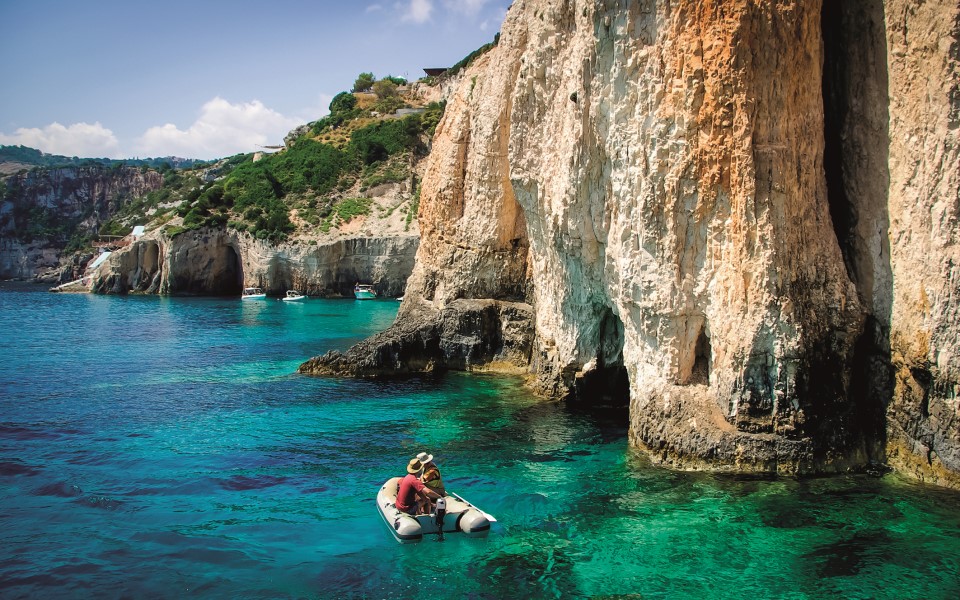
The composition of the rocks in the Blue Caves gives the cavern’s cool waters their distinctive blue glow.
© Shutterstock
“If you’re lucky and the maestro wind is blowing, you can see the Strofadia [two small islands to the south of Zakynthos] on the horizon, as if floating in space,” says an elderly patron of the solitary café in Agalas, a mountain village in the southwest of the island. He leads me to the edge of the village, to the Damianos Cave, a cavern with two levels and two gaping mouths, one above the other, overlooking a mountain vineyard with a number of surviving Venetian wells, dug to catch the rainwater for irrigation.
The hike to the edge of the cliff is a singular experience, as is the view from the Cave Damianos Taverna, its tables and chairs perched on the hillside. Here, I order a homemade savory pie while waiting for the sunset. In the distance to the south, the Strofadia do indeed emerge and, although I can’t see it at this distance, I know that the Kastromonastiro, a fortified Byzantine monastery, stands guard atop the larger island.
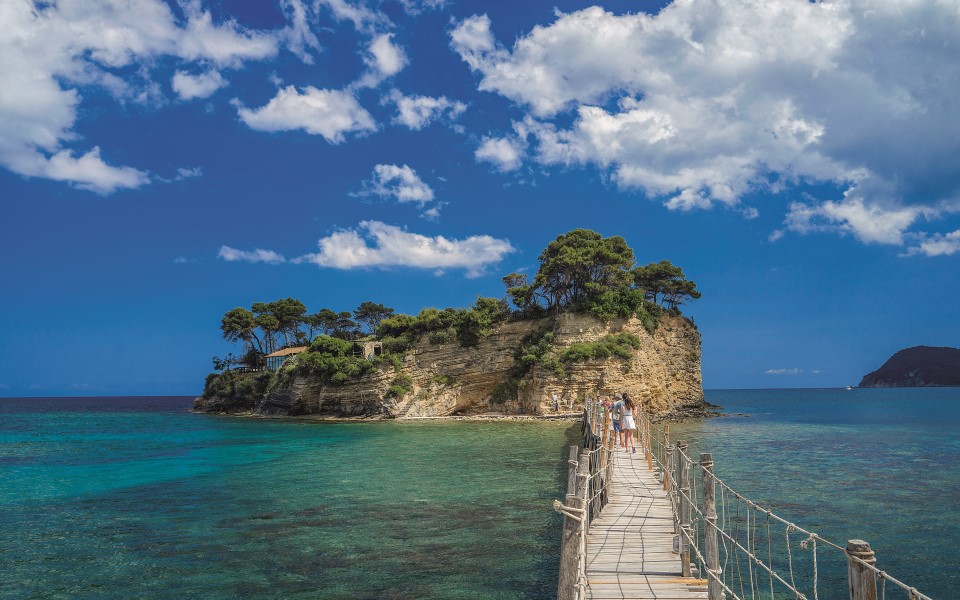
A wooden bridge connects the beach of Aghios Sostis, next to the village of Laganas, with the tiny island of Cameo, a famous backdrop for wedding photoshoots.
© Perikles Merakos
From the taverna, I head towards the village of Kiliomenos with its peculiar polygonal bell tower bearing unusual carved symbols, and take a right turn towards Ampelostrates, a simple restaurant in the woods, located among a scattering of Roman ruins.
Owner and cook Antonis Maroudas uses local ingredients to produce some of the tastiest Zakynthian dishes, adding his own knowing touches to treasures such as savory pies made with traditional local cheeses and wild greens, and skordostoumpi (eggplant with garlic, vinegar and tomatoes). He uses eggs from his own chickens, and serves the creamiest, most buttery cheese, matured on wooden planks. Tonight I’m in luck, as the restaurant is hosting a live jazz performance, which I can enjoy with some Verdea, Avgoustiatis or Goustolidi, the best of the local wine varieties.
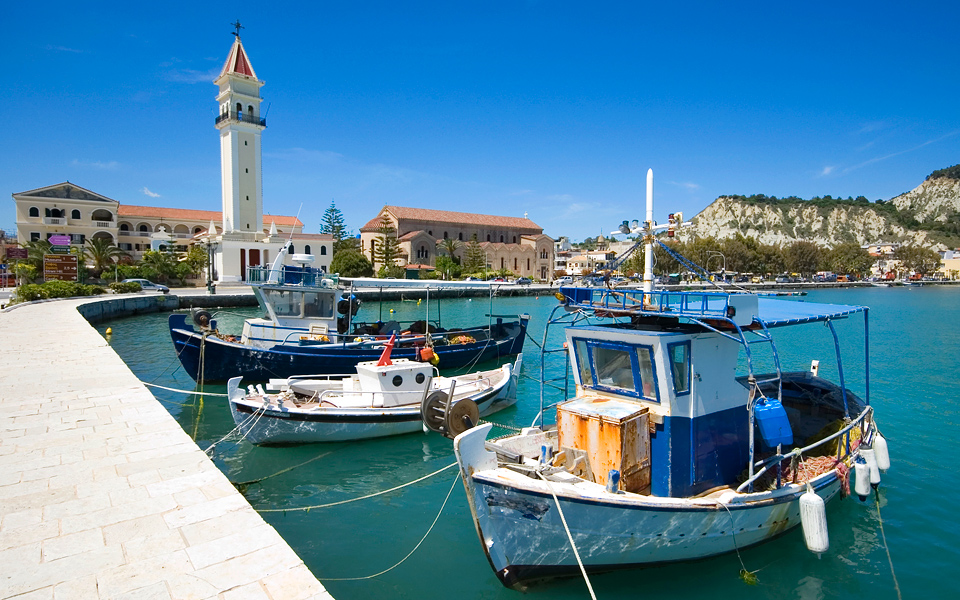
Venetian influences can still be easily found in the island's architecture.
© Shutterstock
However many days I spend on the island, I’ll never get around to swimming at all of its beaches. There are just too many of them. I can, however, name my favorites: Kalamaki, with its 6km stretch of seemingly endless sand dunes; Limnionas, with its white rock fjords (very busy in previous high seasons); and the beaches of Banana Casa Playa, Aghios Nikolaos, Kaminia, Porto Zoro, Porto Roma and Porto Azzuro, all of which are great for water sports and feature charming beach bars.
There’s Makry Gialos, too, with its pebbled shore and clear waters; Gerakas, perhaps the prettiest sandy beach on the island, with its impressive rock formations and hundreds of protected sea turtle nests; and Korakonisi, where the sparkling turquoise waters are offset by a backdrop of soaring rock walls.
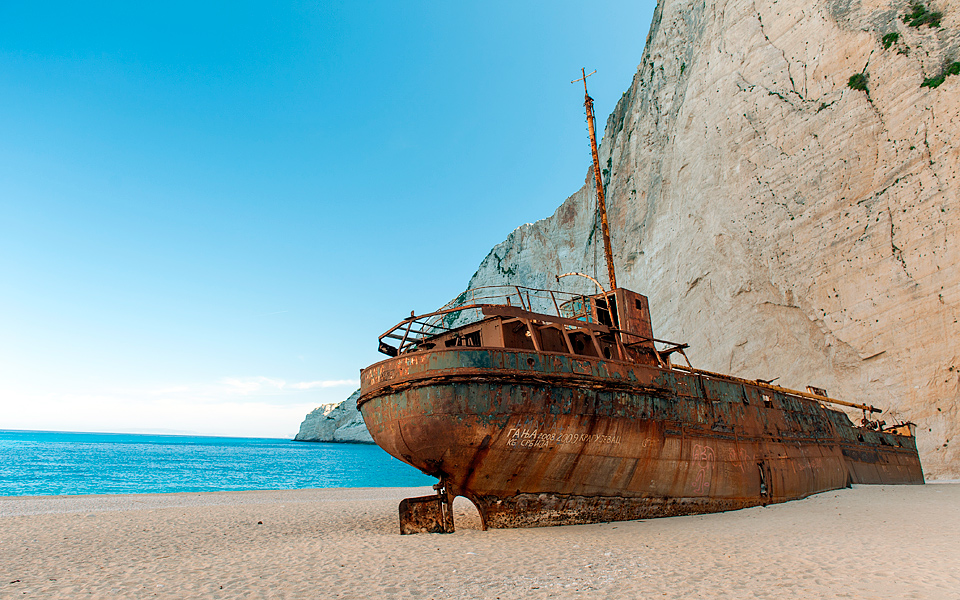
The world-famous Navagio (Shipwreck) Beach.
Yes, it’s undoubtedly touristy, but you simply must pay a visit to one of the most other-worldly locations in Greece. The vertical 300-meter rock face, the legacy of a restless geological past, seems to have been sliced by a knife. The beach is on the western side of Zakynthos, and the best time to visit it is around sunset, accessing it either overland or by sea taxi.
Navagio is a spot of incomparable beauty, but visitors need to take special care. You shouldn’t swim in the bay unless the sea is absolutely calm. Navagio started drawing visitors in 1982, when the cigarette-smuggling boat “Panagiotis” beached here. Zakynthians never swam at the beach prior to that, as the sea bottom drops precipitously, meaning the waters are deep, the sea swell is treacherous, and the currents can easily drag unwary swimmers out to sea.
Also, whatever you do, do not approach the cliff edge above the beach for a selfie. The rocks around the lip are apt to crumble and the true edge itself is often concealed by dense scrub.
Do not climb onto the wreck to take photos. There is a grave risk of injury. Also, please do not break off bits of the boat to take as souvenirs. Instead, take a photograph!
A brand new beach appeared on the island in October of 2018 when an earthquake measuring 6.8 on the Richter scale caused a number of landslides across the island, one of which created a narrow sandy stretch of land that reached the two sea rocks known as the Myzithres, off the coast near the village of Keri. This small white sandy beach can only be reached by sea.
Stenitis is another picture-perfect beach, well off the beaten path. This small sandy beach faces a long, narrow fjord, located along the route taken by the boats from Porto Vromi to Navagio. The calm, crystalclear water here is the color of emeralds. You can also reach this beach by road from the village of Maries.
The Jewish cemetery is on the hill of Bohali, with a view of the town and the sea, in a quiet olive grove. It’s perhaps paradoxical that this place of final rest also serves as a reminder of an important moment in local history when life triumphed over death; during the German occupation of Zakynthos in WWII, the mayor of Zakynthos Town and the bishop of the island worked together to save all of the island’s Jews from deportation to the camps.
Buy a wooden mortar and pestle to make your own aliada, the island’s traditional garlic paste. Few craftsmen still make them, but one of the best is Dionysis Kladis. His workshop is on the main road between Kiliomenos and Aghios Leontas (Tel. (+30) 26950.273.58, or (+30) 697.464.6563).
If you find yourself wandering the Zakynthos countryside in August, you’ll be struck by the smell of freshly harvested grapes drying in the sun. The fruit is spread on concrete threshing floors to dry, after which the shiny little jet-black raisins, also called currants, are exported abroad. At the Farming Co-Op headquarters by the port, you can buy them by weight or prepackaged, either plain or dipped in dark chocolate – one of the tastiest sweet snacks.
The island’s three most well-known products – wine, raisins and olive oil – all go into the traditional island rusks, along with orange juice. My personal favorites are made by the Diaolis bakery (Tel. (+30) 26950.632.96) on the main street in the village of Aghios Kirikos. Choose the unsweetened variety, with its wonderfully crumbly texture and unique flavor.
Climate change brings water scarcity and...
From Santorini sunsets to ancient ruins,...
With its beautiful olive groves, emerald...
Experience Spetses in its most enchanting...